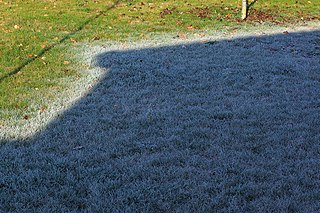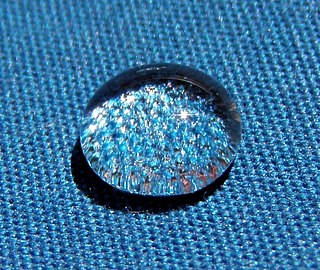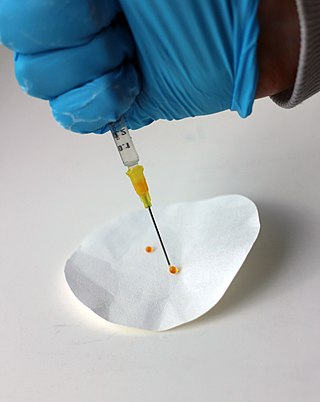
Frost is a thin layer of ice on a solid surface, which forms from water vapor that deposits onto a freezing surface. Frost forms when the air contains more water vapor than it can normally hold at a specific temperature. The process is similar to the formation of dew, except it occurs below the freezing point of water typically without crossing through a liquid state.

In chemistry, hydrophobicity is the chemical property of a molecule that is seemingly repelled from a mass of water. In contrast, hydrophiles are attracted to water.
In physics and chemistry, flash freezing is the process whereby objects are rapidly frozen. This is done by subjecting them to cryogenic temperatures, or it can be done through direct contact with liquid nitrogen at −196 °C (−320.8 °F). It is commonly used in the food industry.

Cloud physics is the study of the physical processes that lead to the formation, growth and precipitation of atmospheric clouds. These aerosols are found in the troposphere, stratosphere, and mesosphere, which collectively make up the greatest part of the homosphere. Clouds consist of microscopic droplets of liquid water, tiny crystals of ice, or both, along with microscopic particles of dust, smoke, or other matter, known as condensation nuclei. Cloud droplets initially form by the condensation of water vapor onto condensation nuclei when the supersaturation of air exceeds a critical value according to Köhler theory. Cloud condensation nuclei are necessary for cloud droplets formation because of the Kelvin effect, which describes the change in saturation vapor pressure due to a curved surface. At small radii, the amount of supersaturation needed for condensation to occur is so large, that it does not happen naturally. Raoult's law describes how the vapor pressure is dependent on the amount of solute in a solution. At high concentrations, when the cloud droplets are small, the supersaturation required is smaller than without the presence of a nucleus.

The hydrophobic effect is the observed tendency of nonpolar substances to aggregate in an aqueous solution and to be excluded by water. The word hydrophobic literally means "water-fearing", and it describes the segregation of water and nonpolar substances, which maximizes the entropy of water and minimizes the area of contact between water and nonpolar molecules. In terms of thermodynamics, the hydrophobic effect is the free energy change of water surrounding a solute. A positive free energy change of the surrounding solvent indicates hydrophobicity, whereas a negative free energy change implies hydrophilicity.

Deicing is the process of removing snow, ice or frost from a surface. Anti-icing is the application of chemicals that not only deice but also remain on a surface and continue to delay the reformation of ice for a certain period of time, or prevent adhesion of ice to make mechanical removal easier.

Rime ice forms when supercooled water droplets freeze onto surfaces. In the atmosphere, there are three basic types of rime ice:

Wetting is the ability of a liquid to displace gas to maintain contact with a solid surface, resulting from intermolecular interactions when the two are brought together. This happens in presence of a gaseous phase or another liquid phase not miscible with the first one. The degree of wetting (wettability) is determined by a force balance between adhesive and cohesive forces. There are two types of wetting: non-reactive wetting and reactive wetting.

In thermodynamics, nucleation is the first step in the formation of either a new thermodynamic phase or structure via self-assembly or self-organization within a substance or mixture. Nucleation is typically defined to be the process that determines how long an observer has to wait before the new phase or self-organized structure appears. For example, if a volume of water is cooled significantly below 0 °C, it will tend to freeze into ice, but volumes of water cooled only a few degrees below 0 °C often stay completely free of ice for long periods (supercooling). At these conditions, nucleation of ice is either slow or does not occur at all. However, at lower temperatures nucleation is fast, and ice crystals appear after little or no delay.

Cassie's law, or the Cassie equation, describes the effective contact angle θc for a liquid on a chemically heterogeneous surface, i.e. the surface of a composite material consisting of different chemistries, that is, non-uniform throughout. Contact angles are important as they quantify a surface's wettability, the nature of solid-fluid intermolecular interactions. Cassie's law is reserved for when a liquid completely covers both smooth and rough heterogeneous surfaces.

In chemistry and materials science, ultrahydrophobic surfaces are highly hydrophobic, i.e., extremely difficult to wet. The contact angles of a water droplet on an ultrahydrophobic material exceed 150°. This is also referred to as the lotus effect, after the superhydrophobic leaves of the lotus plant. A droplet striking these kinds of surfaces can fully rebound like an elastic ball. Interactions of bouncing drops can be further reduced using special superhydrophobic surfaces that promote symmetry breaking, pancake bouncing or waterbowl bouncing.

In aeronautics, ice protection systems keep atmospheric moisture from accumulating on aircraft surfaces, such as wings, propellers, rotor blades, engine intakes, and environmental control intakes. Ice buildup can change the shape of airfoils and flight control surfaces, degrading control and handling characteristics as well as performance. An anti-icing, de-icing, or ice protection system either prevents formation of ice, or enables the aircraft to shed the ice before it becomes dangerous.
Adsorption is the adhesion of ions or molecules onto the surface of another phase. Adsorption may occur via physisorption and chemisorption. Ions and molecules can adsorb to many types of surfaces including polymer surfaces. A polymer is a large molecule composed of repeating subunits bound together by covalent bonds. In dilute solution, polymers form globule structures. When a polymer adsorbs to a surface that it interacts favorably with, the globule is essentially squashed, and the polymer has a pancake structure.
The strength of metal oxide adhesion effectively determines the wetting of the metal-oxide interface. The strength of this adhesion is important, for instance, in production of light bulbs and fiber-matrix composites that depend on the optimization of wetting to create metal-ceramic interfaces. The strength of adhesion also determines the extent of dispersion on catalytically active metal. Metal oxide adhesion is important for applications such as complementary metal oxide semiconductor devices. These devices make possible the high packing densities of modern integrated circuits.

A superhydrophobic coating is a thin surface layer that repels water. It is made from superhydrophobic materials, and typically cause an almost imperceptibly thin layer of air to form on top of a surface. Droplets hitting this kind of coating can fully rebound. Generally speaking, superhydrophobic coatings are made from composite materials where one component provides the roughness and the other provides low surface energy.
The surface chemistry of paper is responsible for many important paper properties, such as gloss, waterproofing, and printability. Many components are used in the paper-making process that affect the surface.
A slippery liquid-infused porous surface (SLIPS), liquid-impregnated surface (LIS), or multi-phase surface consists of two distinct layers. The first is a highly textured or porous substrate with features spaced sufficiently close to stably contain the second layer which is an impregnating liquid that fills in the spaces between the features. The liquid must have a surface energy well-matched to the substrate in order to form a stable film. Slippery surfaces are finding applications in commercial products, anti-fouling surfaces, anti-icing and biofilm-resistant medical devices.
Self-cleaning surfaces are a class of materials with the inherent ability to remove any debris or bacteria from their surfaces in a variety of ways. The self-cleaning functionality of these surfaces are commonly inspired by natural phenomena observed in lotus leaves, gecko feet, and water striders to name a few. The majority of self-cleaning surfaces can be placed into three categories:
- superhydrophobic
- superhydrophilic
- photocatalytic.

Liquid marbles are non-stick droplets wrapped by micro- or nano-metrically scaled hydrophobic, colloidal particles ; representing a platform for a diversity of chemical and biological applications. Liquid marbles are also found naturally; aphids convert honeydew droplets into marbles. A variety of non-organic and organic liquids may be converted into liquid marbles. Liquid marbles demonstrate elastic properties and do not coalesce when bounced or pressed lightly. Liquid marbles demonstrate a potential as micro-reactors, micro-containers for growing micro-organisms and cells, micro-fluidics devices, and have even been used in unconventional computing. Liquid marbles remain stable on solid and liquid surfaces. Statics and dynamics of rolling and bouncing of liquid marbles were reported. Liquid marbles coated with poly-disperse and mono-disperse particles have been reported. Liquid marbles are not hermetically coated by solid particles but connected to the gaseous phase. Kinetics of the evaporation of liquid marbles has been investigated.

Droplet cluster is a self-assembled levitating monolayer of microdroplets usually arranged into a hexagonally ordered structure over a locally heated thin layer of water. The droplet cluster is typologically similar to colloidal crystals. The phenomenon was observed for the first time in 2004, and it has been extensively studied after that.













